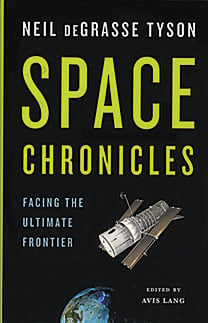REVIEW: Space Chronicles: Facing the Ultimate Frontier
Book by Neil deGrasse Tyson
Share
 Appearing on The Daily Show to promote his latest book, astrophysicist Tyson politely informed Jon Stewart that the image of Earth that appears at the opening of his show “is spinning in the wrong direction.” It was a great line from the director of the American Museum of Natural History’s Hayden Planetarium, who isn’t shy about speaking his mind—especially about the need to reinvigorate the U.S. space program, his impassioned plea in Space Chronicles.
Appearing on The Daily Show to promote his latest book, astrophysicist Tyson politely informed Jon Stewart that the image of Earth that appears at the opening of his show “is spinning in the wrong direction.” It was a great line from the director of the American Museum of Natural History’s Hayden Planetarium, who isn’t shy about speaking his mind—especially about the need to reinvigorate the U.S. space program, his impassioned plea in Space Chronicles.
After decades of being the world superpower in space, NASA’s influence is faltering, while nations like China quickly catch up. As Tyson reminds us, humans first set foot on the moon in 1969 and, after five more manned landings, haven’t been back since 1972. While other technologies from the sixties seem ridiculously outdated now, he writes, when it comes to space travel we “haven’t surpassed the Saturn V,” the rocket that enabled every Apollo mission to the moon during those years. This despite the fact that people once expected we’d have moon bases and Mars colonies by the 1990s—an idea that’s still science fiction today.
People complain that space missions are too expensive, an argument that Tyson is fond of dismantling. When asked to justify the $3.3-billion price tag of the Cassini mission to Saturn and its moons, Tyson points out that it’s a 12-year mission, so the real price tag is under $300 million per year. “Americans spend more than that on lip balm.”
Space Chronicles, which features essays, interviews, a poem, and even tweets from Tyson’s account, is ultimately a cri de coeur for more investment and funding in the space industry, which helps us understand the universe and our place in it. NASA funding amounts to “half a penny” per tax dollar Americans pay, Tyson says; he encourages us to imagine, if this amount were increased to even a full penny, what the space program might do.